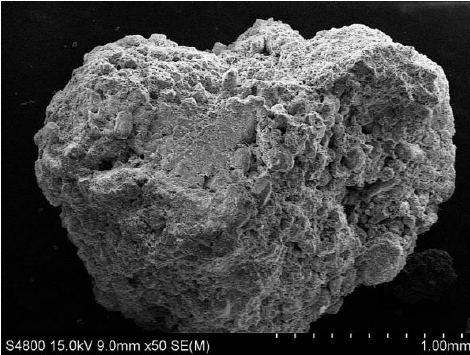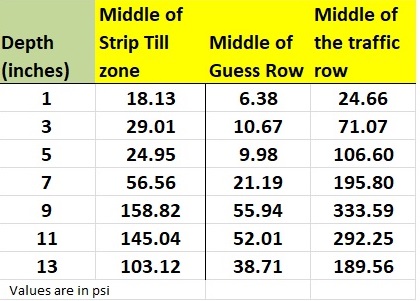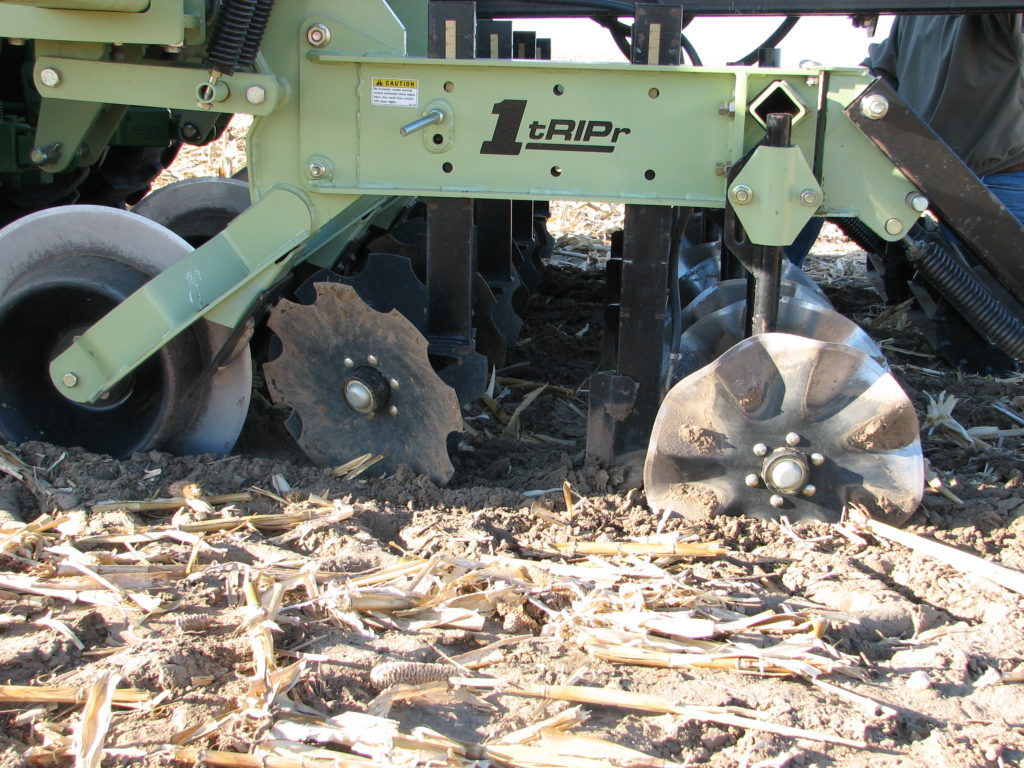Published October 7, 2019 | By Mike Petersen
Orthman 1tRIPr soil resistance studies tell a story of what Strip-Till is all about
In my last report on September 30th, I offered some more of our observations how this spring (2019) affected soils, with strip tillage, plant root growth and some of the parameters of what the root does to compensate for compacted soils. We looked at three different row sites in the study; in the present years row where corn is growing, in the mid section of a row where the tractor tires rode and last the guess row. Those spots are sites in the field for row crop farmer they understand where the soils should be the toughest [wheel traffic rows], where the soil should be the most mellow and what is happening right where the plant lives. It is our aim for you the reader to gain a better perspective of what the soil gives or resists to the newly planted crop baby root system, will any of the plants have to put out more or less energy to gain access to water and soil-solution nutrients for growth?
Before I dive in, I want to ask you a question – how many of your implement dealerships, fertility providers, agronomic scout/consultants, seed dealers even; offer you the kind of information we at Orthman Manufacturing are sharing? Yup, thought so. Does not surprise me. Excuse my chasing you with a loaded question, however we in the wide-wide world of tillage, folks assume too much that certain tillage events are necessary when they truly may or may not be to grow your crops. We have assumed since man started using an ox to pull a rudimentary plow that turning the soil over and over was the way to prepare a seedbed. Well not quite so. Nor should we always assume that the Direct Seeding method offers the “perfect” answer to solving the farmers past soil woes of erosion, runoff, lack of the soil breathing or intake of water, loss of carbonaceous materials, declining soil health, and a poor response to commercial fertilizers. So where do we situate ourselves you may ask? Moldboard plowing and four or more subsequent passes before a planter or drill inserts seeds is most usually detrimental to soil physical properties, biological life and response. Okay what works best on your fields Mister? As a soil scientist now for 45+ years, one who came out of the era of acute awareness of soil quality/health, when Conservation Tillage was getting its roots established and defining what it was and what was not in the USDA-Soil Conservation Service — I can tell you this has been much of a journey of change and for some growers even confusion. I can tell you it was infused into our daily lives to understand and articulate the principles, the modes of action, the good practices versus those that harm soils all across North America. I excavated soils on level soil landscapes to mountain sides as a public servant to better understand whether soils were resilient, conducive to erosion by water and wind, whether soils are of a prime farmland designation or wildlands and a whole lot more. I digress – whether in my travels for work I believe in taking care of the finite soil resource. I have seen and dug in soils in the lands of Queensland, Australia and New South Wales, the Saucony of France, the rich valley of the Volga River, the amazing soils of the Danube in Serbia and Hungary, the High Feldt of South Africa, western Plains of Kansas, the loessal soils of Nebraska, and the lake bed areas of northern Ohio. Most farmers want their soils to be the most productive. I throw in a BUT here. The old ways still pursue, haunt, follow or guide them to achieving what they hope will be produced. So what works Mike Petersen?
Less inversion tillage for sure. Slicing, dicing, rolling, tumbling, and crushing soil aggregates are not the way for sure. With all the soils I have tipped a spade into, now in 5 continents, I have come to a critical point that we agriculturists have flagellated the soil resource far too much, expected big response from those soils and have been disappointed whether the climatic conditions were primo or not. My observations, digging, studying over the 45+ years have shown me that strip tillage in a concentrated band that does not shear soil and roll it like a plow or disk works extremely well. Is it the next best operation/practice to accomplish? Closer than anything else.
With certain tillage that tumble, smear and crash soil these events have a detrimental cause and effect?
Image 2 – SEM micrograph of a soil microaggregate Courtesy: Researchgate.net, Spain
Soil aggregates and microaggregates are thrashed around, microscopic pores, channels and cracks between aggregates are crushed, squeezed, smeared when too moist, organic components are dislodged from the silt and clay particles and when exposed to the sun and warmer air they volatilize and waft away. So as you see with the image to the left (the 11 dots in lower right corner give you an idea of the size of this microaggregate at 1 micron in size). Itty bitty creatures, amoeba, bacteria are mashed, rolled, crushed and exposed to the atmosphere and the soil-water films are dried to extinction. Earthworms are dislodged from their burrows and then either rolled, crushed or cut in two – some make it and others die. Sounds like a battle zone – yes? I paint a pretty bad scene I know. Can we avoid such? I do not mean to be a scolding momma, but to point out these little particles of the soil form into larger ones to make aggregates and soil structural units such as crumb, granules, tiny little blocks or prisms which are the foundation of good, healthy soils. It takes these tiny pieces to make the soil come together in specific forms/shapes, provide a good medium for water to penetrate as well as roots, as well as mycorrhizae hyphae and organic compounds to adhere to the soil and the roots to supply nutrients from the microbes and in the soil solution between and on the microaggregates. It all all must work and stick together in a fashion. What a marvelous world below our feet where roots grow and thrive or work hard to penetrate that I have had the privilege to study, work with and get paid doing it.
Maybe one or two of you may understand a touch more why I have had my head looking in holes in the ground for over 40 years to see the marvels and mystery of the soil. Often I have wished to have a scanning electron microscope at my disposal, but I am not capable of dropping 3-5M dollars on such an instrument – whewie! The intricacies of the soil, how they glue together to form into a cohesive angular blocky structure for instance is vital to soils having resiliency and high value to a growing root.
The chart in Image 3 is from a field that has been in strip tillage since 2002 under overhead sprinkler irrigation. The rotation of crops has been continuous corn for 7 years, soybeans for 1 year, irrigated grain sorghum then back to irrigated corn for 8 years. The grower has alternated the depth of strip till knife between 6 to 10 inches. Six inches when soybeans and ten inches when in corn or sorghum. The values you read are from May 2019 when the soil moisture condition was 85% of field capacity. The soil organic matter (SOM) level is 2.4% in the upper 3 inches and 1.95% in the 3 to 6 inch zone.
This soil has been measured for intake rate at the surface for four years in a row during a research study for the Colorado Corn Growers. Prior to strip-tillage we measured intake rates of 0.90 in/hour, then in the fourth year of strip till the intake rate in the guess row was 4.4 inches/hour and in the wheel row (trafficked row) it still had improved to 2.4 in/hr. That is a 4.9 times improvement. We also measured SOM during the same study; the SOM improved from o.75 to 2.0% in 9 years which covered the span of the intake study also. In the last years of the entire study sponsored by Colorado Corn Growers we measured soil aggregate stability of this same soil, the soil aggregate values are measured with a “slaking test” that USDA-NRCS still encourage people to do and their Soil Health Specialists in each state are eager to work with people on. I ran these analyses with one of the progenitors of the soil slake test for aggregate stability, Dr. Robert Grossman, USDA-NRCS Soil Survey Laboratory-Lincoln, Nebraska before this became “a thing” within the USDA. I still run these tests and find amazing results from Strip-Till and No-Tilled soils all across the states I get to dig holes in. The soil aggregates rated a 0 to 1 the first year on a scale of 1 to 5 with 5 being the most stable soil aggregates. In the last year of the study the aggregate stability improved to a 5 demonstrating the aggregates were more stable to water melting the micro and macro-aggregates. All of that to say this field in Eastern Colorado has had many studies and I have had a constant eye (year to year since 2000) on to offer what strip till has done and can do.
As you can see in the chart of penetration resistance, there is a jump in vertical resistance at 8-9 inches. This field was strip tilled at the 9 inch depth this spring. Even in the row where traffic is the jump in resistance is significant. The corn that was growing at the time was at V2 stage and the seedling root had not grown beyond the 5 inch depth so it was not impacted by the soil resistance that would have been felt by the 9 inch depth in the middle of the strip tilled zone column. As has been noted in previous articles on this Precision Tillage website, very young plants will encounter root penetration and elongation at the tip when soil resistance exceeds 60 psi.
I will continue to bring more about our spring soil resistance studies as the next couple weeks come. Stay tuned.


